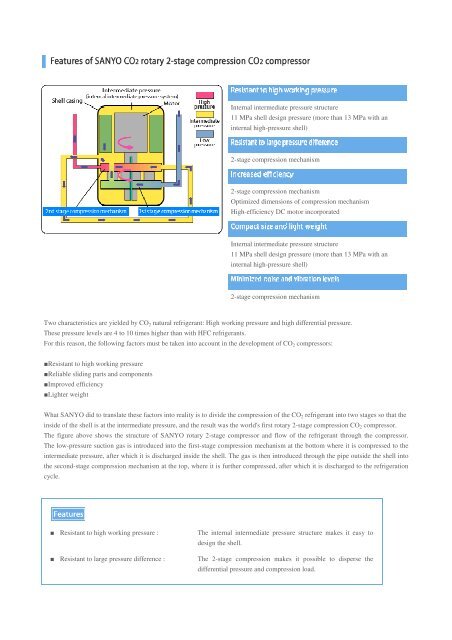SANYO Rotary 2-Stage Compressor
SANYO Rotary 2-Stage Compressor
SANYO Rotary 2-Stage Compressor
Create successful ePaper yourself
Turn your PDF publications into a flip-book with our unique Google optimized e-Paper software.
Internal intermediate pressure structure<br />
11 MPa shell design pressure (more than 13 MPa with an<br />
internal high-pressure shell)<br />
2-stage compression mechanism<br />
2-stage compression mechanism<br />
Optimized dimensions of compression mechanism<br />
High-efficiency DC motor incorporated<br />
Internal intermediate pressure structure<br />
11 MPa shell design pressure (more than 13 MPa with an<br />
internal high-pressure shell)<br />
2-stage compression mechanism<br />
Two characteristics are yielded by CO 2 natural refrigerant: High working pressure and high differential pressure.<br />
These pressure levels are 4 to 10 times higher than with HFC refrigerants.<br />
For this reason, the following factors must be taken into account in the development of CO 2 compressors: ors:<br />
■Resistant to high working pressure<br />
■Reliable sliding parts and components<br />
■Improved efficiency<br />
■Lighter weight<br />
What <strong>SANYO</strong> did to translate these factors into reality is to divide the compression of the CO 2 refrigerant into two stages so that the<br />
inside of the shell is at the intermediate pressure, and the result was the world's first rotary 2-stage compression CO 2 compressor.<br />
The figure above shows the structure of <strong>SANYO</strong> rotary 2-stage compressor and flow of the refrigerant through the compressor.<br />
The low-pressure suction gas is introduced into the first-stage stage compression mechanism at the bottom where it is compressed to the<br />
intermediate pressure, after which it is discharged inside the shell. The gas is then introduced through the pipe outside the shell into<br />
the second-stage stage compression mechanism at the top, where it is further compressed, after which it is discharged to the refrigeration<br />
cycle.<br />
■ Resistant to high working pressure :<br />
■ Resistant to large pressure difference :<br />
The internal intermediate pressure structure makes it easy to<br />
design the shell.<br />
The 2-stage compression makes it possible to disperse the<br />
differential pressure and compression load.
■ Increased efficiency :<br />
■ Compact size and light weight :<br />
■ Minimized noise and vibration levels :<br />
Leakage is reduced by the 2-stage compression, the dimensions<br />
of the compression mechanism are optimized, and a highwalls<br />
due to the internal intermediate<br />
pressure structure, and a compact concentrated winding motor<br />
efficiency DC brushless motor is incorporated.<br />
The shell has thinner is provided.<br />
Equalization of a torque on that of twin rotary compressor is<br />
achieved thanks to the compression mechanism's 2-cylinder<br />
structure in which the two cylinders face each other at 180<br />
degrees.<br />
■ Just right for hot water heaters in cold climates : The internal intermediate pressure structure enables discharging<br />
at a higher temperature than with regular rotary compressors.<br />
Users can select the volume ratio (displacement volume ratio<br />
between the first and second stages) that suits the intended<br />
application, which makes the compressors just right for use in<br />
winter and for water heaters in cold climates.<br />
When the transcritical CO 2 refrigeration cycle is applied in refrigerator and freezer equipment, the theoretical efficiency (COP) is<br />
said to be generally lower than that of HFC. An effective way to offset this is to employ: 1) an internal heat exchanger, and 2) an<br />
intermediate cooler.<br />
■Internal heat exchanger<br />
The cooling performance is enhanced by exchanging the heat between the evaporator r outlet pipe and gas cooler outlet pipe.<br />
■Intermediate cooling<br />
When the CO 2 is compressed in the single stage, the discharge temperature reaches quite a high level. Since intermediate cooling is<br />
enabled by the rotary 2-stage compression mechanism, it is possible to reduce the discharge temperature significantly.<br />
In this way, rotary 2-stage compression CO 2 compressors can offer useful solutions even in the refrigeration and freezing fields<br />
where compressors have had a poor track record to date.
















